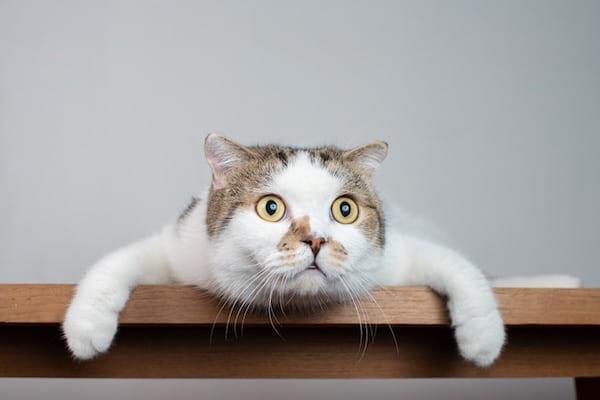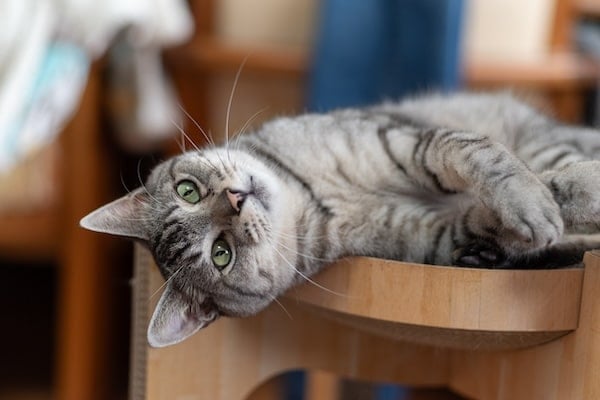Cats are champion starers. Sometimes they stare at what seems to be nothing. Other times, you might catch them staring at you intently, almost as if they’re planning your demise. (Are they?) So is staring normal for a cat? What does it mean?
Some cat staring is just their natural biology: cats only blink two to five times per minute. Humans, by contrast, blink 15 to 20 times per minute. Other times, cat staring can be a form of communication. “Cats likely stare because they want something, such as attention, playtime, or food,” explains certified cat behaviour consultant Dr. Mikel Delgado, PhD, scientist and established cat expert at Feline Minds.
In this piece, we’ll share more of Dr. Delgado’s insights into why cats stare and how pet parents can best respond to meet their feline family members’ needs.
Why Cats Stare
Cats use a combination of body language and vocalisation to express themselves. Staring is one of the tools in their communication toolkit. Let’s look at the various reasons cats stare and what to do in response.
Observing
Cats are infinitely curious and are experts in observation. You may find your cat watching you simply because they’re intrigued by what you’re doing. “Keep in mind that in our homes, we might be the most interesting thing for our cat, so it’s reasonable for them to want to keep an eye on what we are doing,” says Dr. Delgado.
What to do: No action is generally needed if your cat is simply observing you. However, if you think your cat might be bored, you can provide enrichment.
Wanting attention
Your cat may be looking at you as a way to get your attention. They may follow a stare by meowing or trilling, curling around your legs, and tagging along behind you. “Cats are dependent on us to provide for most of their needs, and they usually associate us with the things they want and enjoy,” says Dr. Delgado.
What to do: Try to figure out why your cat is trying to get your attention. Are they hungry? Do they want affection? Have they had enough exercise and playtime for the day? If all your cat’s needs have been met and they’re still restless, there are things you can teach them to help them settle.

Domepitipat via iStock
Asking for help
Another reason why your cat keeps staring at you could be that they need your help. Perhaps they can’t reach their favourite toy and need you to rescue it from under the furniture. Or maybe access to the litter box or water bowl has been blocked off.
What to do: Try to figure out what your cat is asking and do a little bit of investigation to find out.
Injured or ill
Your cat might also be hurt or sick. A fixed or vacant stare could signal health issues like neurological disorders, vision problems, or an injury. A cat’s pupils will also dilate if they’re in pain or experiencing certain health conditions, such as high blood pressure. If your cat is squinting, they might also be in pain.
What to do: If your cat’s staring is accompanied by other symptoms like lethargy and behavioural changes, contact your vet as soon as possible.
Aggressive or overstimulated
If your cat stares at you with big pupils while flicking their tail and flattening their ears, they could be overstimulated or anxious. Tread cautiously, as they could easily escalate to aggressive behaviours, such as lashing out with a scratch or bite.
What to do: Give your cat plenty of space and avoid making direct eye contact or sudden movements. If you were engaging with them, take a break until they ask for your attention again. You may also want to determine what’s stressing them out. Maybe it’s a loud noise or another pet in the home.
Bored or wanting to play
Trying to engage you in play is another reason your cat may stare at you. When you do play with them, their eyes may also dilate. You’ll see this when they get the zoomies.
What to do: Ensure your cat is getting enough mental and physical stimulation throughout the day. Prioritise spending one-on-one time with them to play and provide plenty of enriching items in your house, like cat trees, food puzzles, and chew toys.
Curious
A cat staring with wide dilated pupils is a hallmark sign of an alert and curious cat. Other signs your cat is curious include pricked ears, forward-facing whiskers, and an upright tail with a curved tip.
What to do: Again, no action is needed here. Just watch for any signs of boredom!
Affectionate
When your cat is feeling affectionate toward you, their pupils will be at normal dilation and their brows will be soft. They may offer you the slow blink, often thought of as a kitty smile. A rub against your leg confirms that they are showing you some love.
What to do: Enjoy the snuggles and love from your kitty. Indulge them in some feel-good skritches if that’s what they’re requesting.
Sleeping
What you think is your cat staring at you could actually be your cat taking a quick “cat nap.” Some cats sleep with their eyes partially (or even completely) open. So what seems like your cat staring might not be staring at all—they might just be squeezing in a few extra minutes of shut-eye (or, in this case, open-eye).
What to do: Let sleeping cats lie! Don’t disturb your kitty while they’re catching a few Zs.

rai via iStock
Scared
Cats may display big, saucer eyes when feeling scared or threatened. However, their pupils may also become slits, and their eyelids squinty to protect against possible injury. If your cat is staring at you from a distance (or keeping their distance), they may be fearful of you or something around you.
What to do: Try to determine the cause of your cat’s fear and take steps to alleviate it. Give them a lick mat or a puzzle toy to calm them down in stressful situations. Reassure your kitty they’re safe while also respecting their space.
Hungry
Your cat might be staring at you because they have a want or need that hasn’t been met. Often, it will be food-related, and they’re staring at you to request dinner or a yummy treat.
What to do: Stick to a consistent feeding schedule so your cat always knows when mealtime is. Offer healthy snacks and treats as part of training or “just because,” making sure not to overdo it with portion size.
Hunting
Wide pupils, a crouched position, and that telltale wiggle of the rear end is the classic pouncing stance for a cat. The adorable wiggle is believed to be your cat’s way of getting a good stance to make that powerful leap. You may also see the eyes become thin slits (even when they’re not in bright sunlight). This is a warning sign of a cat ready to attack.
What to do: Offer your cat plenty of opportunities to engage in their natural hunting instincts, like chasing wand toys and batting at string toys.
Soft vs. Hard Stare: Should You Stare Back?
A cat’s direct and unblinking “hard” stare may suggest aggression or discomfort. Because cats may feel intimidated by the direct stare, it’s best that you don’t stare directly at them.
“When cats stare at each other, it can be threatening, so I don’t recommend staring at your cat as it might make them uncomfortable,” says Dr. Delgado. “I much prefer the slow blink, which is a relaxing signal that research has shown cats respond positively to.”
However, if you catch your kitty gazing at you with a “soft stare”—heavy-lidded, half-closed eyes—they’re likely feeling happy, peaceful, and relaxed.
Understanding Cat Body Language
Paying attention to your cat’s whole body, including their tails, ears, and posture, along with taking the environment and context into account, can help you better read what your cat is trying to say.
Dr. Delgado stresses that our cats are dependent on us to meet their needs, which include consistent mealtimes, daily exercise, playtime, and, depending on the cat, cuddles or other types of affection.
“The most important thing to do if your cat is staring at you is to make sure you are meeting those needs,” she says. “A little staring at you is nothing to be worried about and probably just indicates that your cat knows you are their caretaker!”



